
The US economy is facing a significant increase in credit card debt, with more and more consumers needing to catch up on their payments.
The Current State Of US Credit Card Debt
According to the latest Quarterly Report on Household Debt and Credit released by the Federal Reserve Bank of New York, credit card balances in the third quarter of 2023 soared to a record $1.08 trillion. This represents a $48 billion increase from the previous quarter and a $154 billion leap from the previous year. The year-over-year increase is the largest since the New York Fed started tracking this data in 1999.
Household Debt On The Rise
Total household debt followed a similar trend, increasing 1.3% to $17.29 trillion in the third quarter. That’s up 8.39% from the same period back in 2022. This rise in debt is not limited to credit cards alone. Other forms of debt such as auto loans and student loans also saw a notable increase.
Breakdown of The Debt Increase
The following table provides a detailed breakdown of the increases in various categories of household debt in the third quarter:
| Category | Quarterly Change (Billions $) | Annual Change (Billions $) | Total as of Q3 2023 (Trillions $) |
| Mortgage Debt | +$126 | +$471 | $12.14 |
| Home Equity Line of Credit | +$9 | +$27 | $0.349 |
| Student Debt | +$30 | +$25 | $1.599 |
| Auto Debt | +$13 | +$71 | $1.595 |
| Credit Card Debt | +$48 | +$154 | $1.079 |
| Other | +$2 | +$38 | $0.529 |
| Total Debt | +$228 | +$786 | $17.291 |
Data source: Federal Reserve Bank of New York
Delinquency Rates On The Rise
Delinquency rates, representing the percentage of debt that is overdue, also saw an increase in the third quarter. With 3% of outstanding debt in some stage of delinquency at the end of September, delinquency transition rates rose for most debt types, excluding student loans and home equity lines of credit.
The Millennial Debt Crisis
Interestingly, the rise in credit card delinquency rates was particularly pronounced among millennials and those with auto loans or student loans. This group started to exceed their pre-pandemic delinquency levels mid-last year and now have transition rates (from being current on their credit card payments to being delinquent) 0.4 percentage points higher than the third quarter of 2019.
Millennials and Their Debt
According to Yahoo Finance, researchers from the New York Fed said in a press call that “millennials have lower homeownership rates, they may be more exposed to increases in rents, which may be putting pressure on their balance sheets in other ways.”
Millennials are facing a unique set of financial challenges. They have a significant amount of student debt and many took out auto loans during the pandemic when prices were high. The overlap between millennials and these forms of debt correlates with higher delinquency rates.
The Impact of Rising Interest Rates and Inflation
Rising interest rates and persistent inflation are also playing a role in the increasing credit card debt and delinquency rates. The past 18 months have seen a rise in interest rates due to the Federal Reserve’s campaign to control inflation. this has increased the cost of living and shelter, leading borrowers to rely more on credit.
Mortgage and Housing Market Trends
Concurrently, mortgage originations fell to $386.37 billion, marking a period considerably below the high-flying housing activity in 2020 and 2021. This year is on pace to have the lowest origination values since 2014.
Housing Affordability
Many consumers, despite being in strong enough financial shape to buy a home, are not pulling the trigger due to high prices and mortgage rates. About 85% of respondents in a survey released by mortgage giant Fannie Mae said it was a “bad time” to purchase a home. Consumer frustration with the housing market is being compounded by increasing feelings of pessimism towards the larger economy. The survey, conducted in October, also found that 78% of respondents said the economy is on the “wrong track,” up from 71% in September.
The Way Forward: What This Means for the Economy
The surge in US credit card debt and the increasing number of people falling behind on their payments is a concerning trend that warrants close attention. If unchecked, this could potentially result in a significant economic fallout. Earlier this year, Wells Fargo said the increase in delinquincies might be a ‘harbinger’ of a coming recession. As such, further research into the causes of this shift is necessary. Whether it’s a consequence of changes in lending standards, consumers overextending themselves, or an indication of “real financial stress” remains to be seen.
Conclusion
While the rising US credit card debt is alarming, it’s important to remember that it’s not all negative. The higher balances could also reflect population growth, the rise in e-commerce, and a strong economy. However, the increasing delinquency rates and the financial struggles faced by millennials and those with auto or student loans call for urgent attention and intervention.
